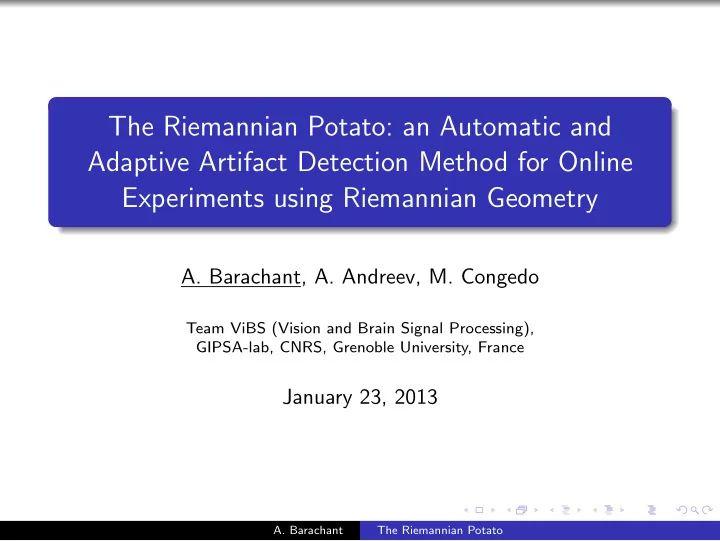

The Riemannian Potato: an Automatic and Adaptive Artifact Detection Method for Online Experiments using Riemannian Geometry A. Barachant, A. Andreev, M. Congedo Team ViBS (Vision and Brain Signal Processing), GIPSA-lab, CNRS, Grenoble University, France January 23, 2013 A. Barachant The Riemannian Potato
Introduction Context : Online BCI experiments Problem : Classification and/or adaptation very sensitive to artifacts. Manual detection impossible. Goal Online Artifacts detection Automatic : No parameters to set manually Adaptive : Adapt to non-stationarity Generic : Not specific to a particular kind of artifacts. A. Barachant The Riemannian Potato
A new definition BCI − → detection of a reference activity Motor Imagery Evoked Potential A New Definition Artifact = ⇒ Any kind of EEG signal different enough as compared to a reference activity. 2 Steps : Characterization of the reference activity. 1 Measuring the similarity. 2 A. Barachant The Riemannian Potato
Covariance Matrices Spatial covariance matrix of EEG signal = ⇒ descriptor of brain activity. Manipulation through Riemannian geometry. A. Barachant The Riemannian Potato
Riemannian Manifold Covariance matrices : Symmetric and positive definite Belong to a Riemannian Manifold. Distance : � � Σ − 1 / 2 Σ j Σ − 1 / 2 δ R ( Σ i , Σ j ) = � log � F i i Reference activity : specific region in the manifold. Principle Define a Region Of Interest (ROI) Point outside the ROI = ⇒ Artifact A. Barachant The Riemannian Potato
Riemannian Potato 1 Center of the ROI : Geometric mean of covariance matrices. � δ R ( Σ , Σ i ) 2 ¯ Σ = argmin Σ i 2 Edge of the ROI : threshold on the distance to the center. δ R ( ¯ Σ , Σ i ) = th = µ + 2 . 5 σ A. Barachant The Riemannian Potato
Illustration A. Barachant The Riemannian Potato
Illustration A. Barachant The Riemannian Potato
Illustration A. Barachant The Riemannian Potato
Illustration A. Barachant The Riemannian Potato
Illustration A. Barachant The Riemannian Potato
Illustration A. Barachant The Riemannian Potato
Illustration A. Barachant The Riemannian Potato
Illustration A. Barachant The Riemannian Potato
Adaptive implementation in OpenViBE Use baseline EEG as reference activity. Adapative geometric mean � 1 α ¯ � 1 − 1 − 1 1 Σ t = ¯ ¯ ¯ t − 1 Σ i ¯ 2 2 2 2 Σ Σ Σ Σ t − 1 t − 1 t − 1 Adaptive threshold (adaptive mean and std) Adapt when δ R ( ¯ Σ t , Σ i ) < th t (if t > 10 s) A. Barachant The Riemannian Potato
Video Openvibe implementation. 7 electrodes Frequency filtering : 1-20 Hz Window for covariance matrix estimation : 1.5 s Initialization : 10 s of baseline signal. A. Barachant The Riemannian Potato
Applications How to use the potato ? 1 Signal processing Ignore corrupted trials ex : Brain switch. ⇒ Improve performance. 2 Paradigm Pause until clean signal. ex : Brain invaders. ⇒ The user learn how to avoid artifacts. A. Barachant The Riemannian Potato
Conclusion Simple method (distance, geometric mean). No parameters to tune manually. Not specific to a particular kind of artifact. Fast training. Adaptive. Integrated in the next official release of OpenViBE. A. Barachant The Riemannian Potato
contact Thank you for your attention. Email : alexandre.barachant@gmail.com Code : Riemannian Potato in OpenViBE : http ://code.google.com/p/openvibe-gipsa-extensions Riemannian Geometry toolbox for Matlab : http ://github.com/alexandrebarachant/covariancetoolbox A. Barachant The Riemannian Potato
Recommend
More recommend